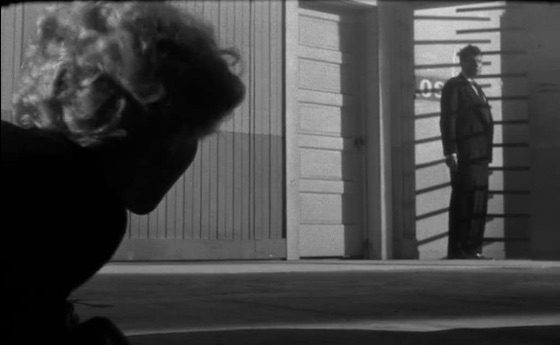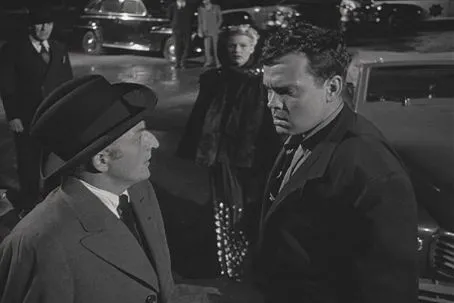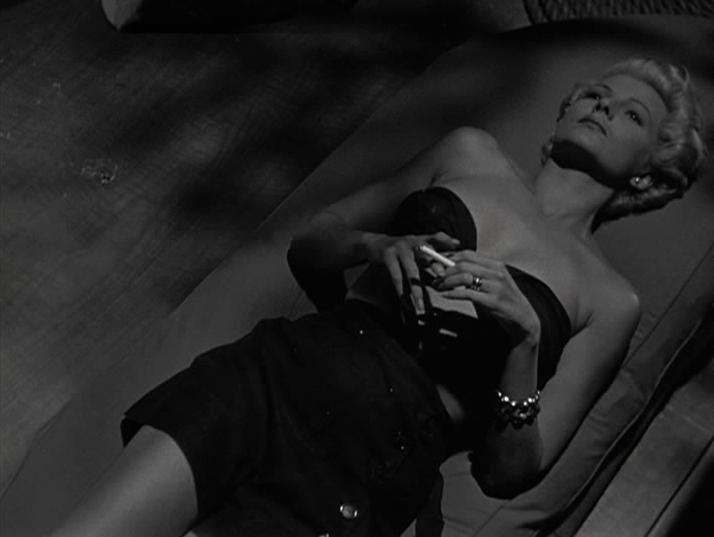Noirs, more than any other genre, have a dreamlike quality to them. Unlike films in other genres, the demand for logic and narrative cohesion isn’t as strict. In fact, the more convoluted, melodramatic, and bizarre a noir film, the better. Few noirs are as confounding and dreamlike as Orson Welles’s The Lady From Shanghai.
Famously, Welles made the movie because a producer had pulled out from his Broadway production of Around the World in 80 Days. Welles had to put up his own money in order to get the wardrobes released, which were being held until payment. Broke, Welles called the producer Harry Cohn and agreed to do a movie for him for no fee in exchange for a loan. Cohn asked what movie Welles had in mind. Welles looked around the lobby, and saw that a young girl in the ticket booth nearby was reading “If I Die Before I Wake” by Raymond Sherwood King, and thus The Lady From Shanghai was born.

It’s one of those movies where the final scene consists of all the main characters spilling the inner contents of their psyches all over the screen. The Lady From Shanghai is a disorganized mess, and were it part of any other genre, it would be a detriment. As it is, it is hardly the only film noir where, after everything has been explained, we are left scratching our heads and wondering how it all fits together.
The movie is infamous for being heavily edited without Welles’s input. Though he gave the studio extensive notes as to how he wanted the film structured and what he wished to leave in, and what he wanted to take out, they went largely unheeded. Peter Bogdanovich, a friend and biographer of Welles as well as a director in his own right, claims that all told, almost an hour of footage is missing from the final cut.
The Lady From Shanghai runs at an hour and twenty-seven minutes. An hour! Can you even imagine?
As it stands, The Lady From Shanghai is a masterclass of surrealism and happy accidents. The film was shot by three different cinematographers, Charles Lawton Jr., Rudolph Mate, and Joseph Walker. (The last two are uncredited.) The movie always feels fractured, like a half-remembered nightmare, but manages to be consistent in its visual tone. Remarkably, the film somehow achieves a rarefied state of both being an innately Wellesian project while also being a hatchet job. The two poles play off each other making the film almost magnetic; it’s impossible to tear your eyes away from it.
The gorgeous black and white photography somehow emboldens the self-made prisons each character has made for themself. Viola Lawrence’s editing gives the cuts, and thus the movie, a strange haunted tone. Whether it be at dusk in Acapulco, or inside the aquarium, the foreground all in black, the only light coming from the fish tanks behind them, the ambiance is always one of mundane dread.
If there is one unifying theme that percolates through every scene is the desire to escape their lives and find happiness as anyone but who they are now. A deep sadness runs underneath every frame as the characters try desperately not to be honest with each other, though at times, honesty erupts to the surface. “Killing you is killing myself.”
Like most noirs, the characters find themselves incapable of telling the truth until it is too late. The script by Welles, along with William Castle, Charles Lederer, and Fletcher Markle, all three uncredited, has a habit of being almost maddeningly obtuse. The tension grows from whether a character chooses to lie just for kicks or tells the truth just to see what happens. Yet, in the mix of it all, Welles and the other writers eke out a sort of poetic prose. “Like the sharks, mad with their own blood chewing away at them own selves.”

If I were to try and describe the plot, I would only confuse you. Suffice it to say that it’s generally agreed upon that the film is about how Welles’s Michael O’Hara falls in love with Rita Hayworth’s Elsa. Michael is an Irish seaman down on his luck and Elsa is a young socialite trapped in a marriage with San Francisco’s famed Defense Attorney Arthur Bannister, played by Everett Sloane.
But that’s to say nothing of how Micahel and Elsa meet. Or how Arthur hires Michael to work on his private yacht as a deckhand at the request of his lovely young wife. It doesn’t even begin to cover the fact that Michael eventually finds himself approached by Arthur’s law partner George Grisby (Glenn Anders) with a deal that involves framing Michael for a murder he won’t commit for a tidy sum that he and Elsa can use to flee the country.
Much like the wheels on the bus, the plot of The Lady From Shanghai goes round and round in a dizzying zig-zag fashion.
I couldn’t help but be awed by how much plot is jammed into the runtime. Despite the bulging story, the film takes its time to unfold. Michael and Elsa fall in love at first sight, like most couples do in the movies. But Welles lets us see them fall into lust, their simmering looks growing in intensity as the film moves from the mainland to the yacht, to Acapulco, and returns to the mainland.
Hayworth and Welles were married at the time of filming. The two share an intense sexual chemistry that is often lacking in other couples. Other couples in movies tend to have a chaste yearning. But Welles and Hayworth gaze at each other with a sort of naked desire that makes us in the audience feel like voyeurs. Indeed, even the camera, which has always loved Hayworth, seems especially stricken by her.

Elsa is an enigma to all around her, and at times, even unto herself. Men all around her desire her and want her and seem to think that she appreciates their attention. We get the sense that with Michael, she genuinely feels affection for him. He seems to be one of the few men in her life to see her as Elsa, the woman, as opposed to Elsa, the sex symbol. All the characters feel trapped, but I would venture to say that Elsa, by virtue of her own past and gender, is the only character who is truly trapped.
The fevered emotions that drive each character helps make the melodramatic curves of the plot seem plausible. Not to mention the deranged population of characters that seem to exist in the film. Glenn Anders, as George Grisby, has a sort of oily demented charm as a man who is clearly not telling Michael everything. His performance is heightened by the actor’s own idiosyncratic quirks, such as the way he seems to relish saying the vowels in his words. After watching The Lady From Shanghai, I guarantee you will find yourself mimicking how Anders’s says the words, “Taaa-r-git Pr-AC-tice.”
Sloane’s Arthur Bannister has a creepy charisma about him. Bannister finds the most unsettling ways to call Elsa “Lover.” His voice rings with a demented merriment. It’s as if he’s taunting her with something she can never have.
Welles’s deep voice narrates most of the picture, acting like his own Greek chorus. His Michael is a hapless fool who always begins to pick up that things are not right just a second or two too late. He tends to find himself in situations in which he can’t quite figure out how he got there.
Grisby has asked Michael to confess to murdering him, but Grisby won’t actually be murdered; he’s only faking his death for the insurance money. So, of course, Grisby ends up dead, for real, and Michael is left on the hook. Good thing he just so happens to know one of the greatest defense attorneys in the country.
The Lady From Shanghai is one of those movies that feels like the film itself is smirking at you. As if Welles is saying, “You can’t possibly be taking any of this seriously?” An avid magician, Welles knows how to distract, beguile, and lure us into his world. While we’re busy scoffing at the movie and scratching our heads, we don’t even notice how we’re leaning in.
A prime example is the preposterous courtroom scene. I couldn’t help but laugh at the audacity of having Michael be on trial for his life while also having Arthur mock him for getting himself into such a situation. Arthur, of course, knows Michael didn’t kill George, but he also knows Michael loves Elsa. So, he attempts to do the best worst job he can. That Welles pulls it off is not surprising, but that he pulls it off so gloriously and so joyously as he frames the courtroom like a giant chess set is a perfect example of winking at the audience.
The end of the movie takes place in the Little Tokyo district of San Francisco, and Welles, who shot on location whenever possible, makes San Francisco seem bigger than just three streets. So many movies tend to focus on just one block of a town, but Welles manages to go all over the world and all over a city and makes you feel the grandiosity and diversity of locations.
I loved all the little details Welles went out of his way to put in. Such as two Japanese teenage Bobbysoxers sitting in the audience of the courtroom scene, gossiping about the case. These things, while tiny, make the world inside the film seem so much grander and exposing how silly, yet tragic, our characters really are.
The final shootout in the funhouse is a scene so ingrained into popular cinematic culture that even if you haven’t seen or heard of The Lady From Shanghai, you will have seen some form of ode or homage to it. At long last, the movie, which has been hanging onto its hinges for a little over an hour, finally becomes unhinged. Confessions spill out over surreal, haunting imagery as bullets fly and bodies fall.
The Lady From Shanghai is almost a parody of itself in how absurd and convoluted it is. It’s a terrific ending. But, to the film’s credit, it’s a terrific movie. For a movie that is essentially a studio hatchet job, it is a magnificent butchery.
Images courtesy of Columbia Pictures

